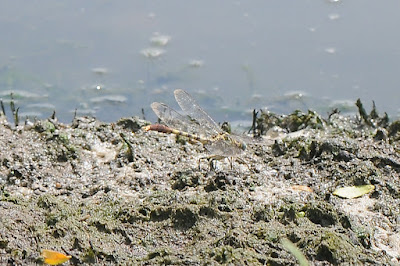It's hard to believe that it's been more than a week since my last update on this blog! Here is a July update.
First focusing on butterflies, a trip to Ledges State Park or two and other odds-and-ends around town have yielded about 26 species of butterflies this week.
Starting with skippers, DUN SKIPPERS are the most common plain-brown skipper in these parts:
Perhaps the easiest skipper to ID as well as one of the most eye-catching is the SILVER-SPOTTED SKIPPER. These seem to be fairly common at this point in the season:
I hadn't seen a FIERY SKIPPER for quite a while this summer. I finally broke that streak and spotted this one down the trail from my apartment here in Ames:
This dark and rather bland butterfly is a type of "spread-wing skipper". More specifically, it's called a WILD INDIGO DUSKYWING:
Switching to sulphurs, I saw my first DAINTY SULPHUR of the summer:
As typical for these parts, SUMMER AZURES continue to be common. Note the lack of orange tones which you would find on Eastern Tailed-Blues:
I was happy to spot this COMMON SNOUT sitting on a road. This is typically a southern species that makes it up into Iowa in late-summer but as far as I know, is never abundant. It uses Hackberry trees (Celtis sp) as the larval foodplant:
One of my favorite butterflies that I've learned here in Iowa is the bright BRONZE COPPER (see also the header at the top of this blog). This one was down in Polk County:
You can't forget the swallowtails. This EASTERN TIGER SWALLOWTAIL was down the trail from my apartment:
I also stumbled on some skippers that I can't ID, might it be a Crossline Skipper? Or maybe a Northern Broken-Dash:
I don't even know where to begin with this one; it looks like it might be rather worn out or bleached:
So as far as I can remember, here is the list of butterflies from this week:
Eastern Tiger Swallowtail
Black Swallowtail
Cabbage White
Clouded Sulphur
Orange Sulphur
Dainty Sulphur
Bronze Copper
Eastern Tailed-Blue
Summer Azure
Great Spangled Fritillary
Meadow Fritillary
Eastern Comma
Mourning Cloak
Red Admiral
Common Buckeye
Red-spotted Purple
Viceroy
American Snout
Monarch
Silver-spotted Skipper
Wild Indigo Duskywing
Common Sootywing
Fiery Skipper
Least Skipper
Dun Skipper
Northern Broken-Dash/Crossline Skipper
Now on to dragonflies....
I haven't seen much diversity this week mainly due to a lack of effort. I still snapped some pictures here and there though.
WIDOW SKIMMERS continue as one of the most abundant species, sometimes even showing up in my yard:
This JADE CLUBTAIL only represents the second time I've found one of these on my own. They are said to be the most common of the pond clubtails here in Iowa, however.
I'm still having a surprisingly difficult time with some of these meadowhawks; I'm thinking this is a RUBY MEADOWHAWK? I don't see much color on the inner-wing, however. Either way, it posed nicely:
Believe it or not, this following species has a worldwide distribution! It is appropriately named the WANDERING GLIDER. I finally found my over-due lifer at Ledges State Park:
What do you do when you take a very crappy picture of a dragonfly? Edit it (screw it up) until it looks artistic! That's what I did with this PRINCE BASKETTAIL flying over my house:
This behemoth of a thing flew past me at Ledges. I was hesitant even approaching it for photos. Whatever it is, I'm glad I don't see them more often:


















































